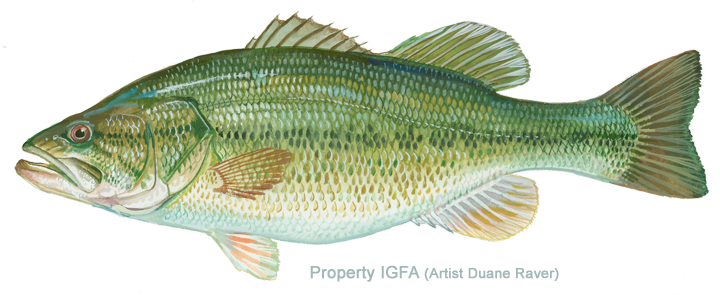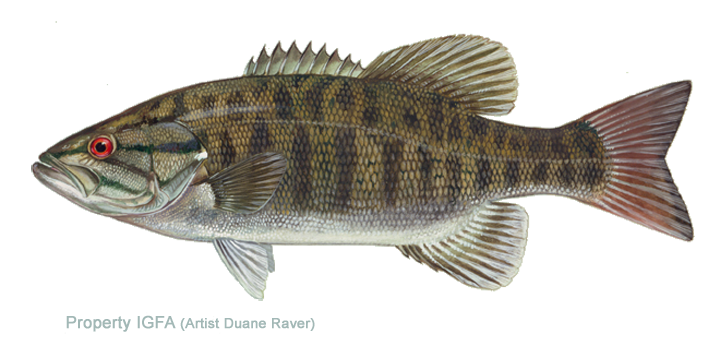Game Fish Identification Reference Guides
Bass, largemouth
(Micropterus nigricans/salmoides)
(Micropterus nigricans/salmoides)

(Lacepede, 1802); CENTRARCHIDAE FAMILY; also called black bass, Oswego bass, green bass, green trout, northern largemouth.
Originally confined primarily to the eastern United States of American and portions of northern Mexico and southern Canada, this member of the sunfish family can be found in every state in the U.S.A., throughout Mexico and Central America, and in many other countries throughout the world.
The largemouth bass very closely resembles the smallmouth bass (Micropterus dolomieu) and other species of the genus Micropterus (i.e., spotted bass, redeye bass, etc.). Together these fishes form a group that is referred to as the black basses. The largemouth can be distinguished from most similar species by the fact that its mouth extends at least to, and often beyond the rear edge of the eyes. Also, its first and second dorsal fins are almost separated by an obvious deep dip, and there are no scales on the soft rayed second dorsal fin. These characters are equally true of the Florida largemouth bass and the northern largemouth bass. In all other species of Micropterus the mouth does not extend to the back of the eyes, the two dorsal fins are clearly connected, usually with a slight dip between them, and the scales overlap the base portion of the second dorsal fin.
They are the most popular freshwater game fish. Much of its popularity is due to its pugnacious attitude and willingness to strike a lure or bait with explosive force. Research indicates that the largemouth bass is also the most intelligent freshwater fish, able to distinguish and avoid a particular type of lure after only one encounter with it. In fact, some bass lakes believed to be “fished out” contain plenty of bass but the fish have learned to recognize virtually all the lures in common use on the lake. In such cases, a lure that is new to them will often work where others have failed. By comparison the brook trout will strike a particular lure two, three or four times before it learns; sunfish and crappies will take the same lure repeatedl
Originally confined primarily to the eastern United States of American and portions of northern Mexico and southern Canada, this member of the sunfish family can be found in every state in the U.S.A., throughout Mexico and Central America, and in many other countries throughout the world.
The largemouth bass very closely resembles the smallmouth bass (Micropterus dolomieu) and other species of the genus Micropterus (i.e., spotted bass, redeye bass, etc.). Together these fishes form a group that is referred to as the black basses. The largemouth can be distinguished from most similar species by the fact that its mouth extends at least to, and often beyond the rear edge of the eyes. Also, its first and second dorsal fins are almost separated by an obvious deep dip, and there are no scales on the soft rayed second dorsal fin. These characters are equally true of the Florida largemouth bass and the northern largemouth bass. In all other species of Micropterus the mouth does not extend to the back of the eyes, the two dorsal fins are clearly connected, usually with a slight dip between them, and the scales overlap the base portion of the second dorsal fin.
They are the most popular freshwater game fish. Much of its popularity is due to its pugnacious attitude and willingness to strike a lure or bait with explosive force. Research indicates that the largemouth bass is also the most intelligent freshwater fish, able to distinguish and avoid a particular type of lure after only one encounter with it. In fact, some bass lakes believed to be “fished out” contain plenty of bass but the fish have learned to recognize virtually all the lures in common use on the lake. In such cases, a lure that is new to them will often work where others have failed. By comparison the brook trout will strike a particular lure two, three or four times before it learns; sunfish and crappies will take the same lure repeatedl















